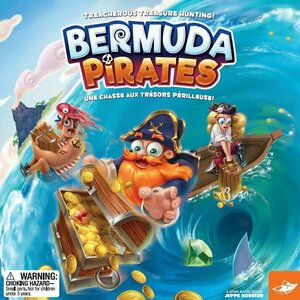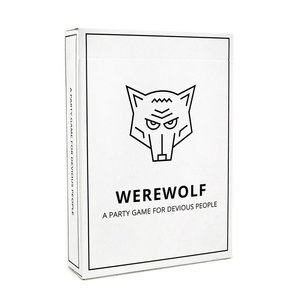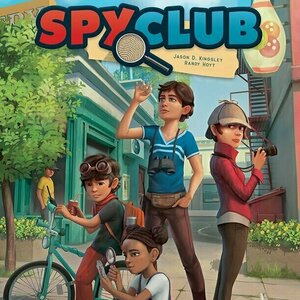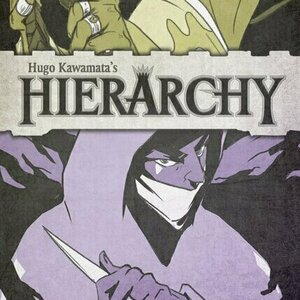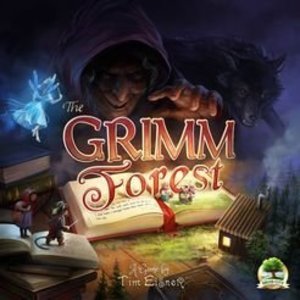Purple Phoenix Games (2266 KP) rated Festival! in Tabletop Games
Nov 24, 2020
Festival! is a competitive set collection game for larger groups, three to seven players. It is set in a medieval kingdom and the game lasts for four festivals. During the game players will be collecting sets of cards to be scored immediately and collecting other cards to be scored at the game’s end.
DISCLAIMER: We were provided a prototype copy of this game for the purposes of this review. These are preview copy components, and I do not know for sure if the final components will be any different from these shown. Also, it is not my intention to detail every rule in the game, but give an idea of how the game plays. You are invited to download the rulebook, back the game through the forthcoming Kickstarter campaign, or through any retailers stocking it after fulfillment. -T
To setup, place the board in the middle of the table. Each player chooses a color of pawn to represent them and places one pawn on the 0 space upon the scoring track and the other pawn in the Festival! area upon the board. The game comes with four different types of cards and each type will be shuffled and placed face-down in stacks as in the photo below. Place the festival marker on either the 0 or 4 space (the rules are not clear, but it is to track the number of festivals, so just choose one) and give the first player busteeple to the youngest player. The game may now begin.
Festival! is played over several turns, but the first three turns will see players taking turns to travel to the different areas of the board and collect cards once they arrive. The initial Festival! area is located between the City and Village areas so a player can choose to move their pawn into either of those areas. As is printed on the board areas themselves, when players arrive in the Country they will immediately draw three Ensemble (green) cards to their hand and their turn is over. A trip to the Village affords the player two Ensemble cards to be drawn, while a visit to the City will allow a player to either draw one Ensemble card OR play as many cards from their hand as they choose. Finally, should the player’s wanderlust urge them to the Palace, they may draw a Palace card to be played to their tableau immediately. Movement from one area to the next is always done to the adjacent area. So if in the Village a player may only move to either the Country or the City. If in the Country a player may only move to the Village.
As I mentioned, the first three turns are head start rounds where players are merely collecting cards to amass a hand (of limit 7) of cards that can be played in sets in their personal tableau. These cards are divided into Exotic, Percussion, Melodic, and Choir cards. Players may play as many cards as they like when in the City, but will score bonus set and superset points if they are able to lay down multiple unique cards in each group. For example, a Horn card is worth one VP alone, but with three other unique Melodic cards earns bonus points for the entire set.
After the first three turns have been played, the first player will then flip a Festival card (stacked on the game board) at the beginning of each turn. It is from this stack that the four “Festival!” cards are located, and they are the time trackers for the game. If the result is “Preparation,” the turns continue as normal with no change. However, should the flipped card be a “Festival!” face, then players within range of the Festival Stages may claim a stage and participate in the festival. Participation in the festival simply means that players may play cards as normally played in the City, but then are entitled to one of the drawn Finale cards. These cards are scored at the end of the game and typically award bonus points for various reasons.
Play continues in this fashion of traveling the board areas to collect cards, performing in festivals, and earning the most amount of VP at game end, which is immediately following the fourth festival. The player with the most VP is the winner!
Components. Again, this is a prototype copy of the game, so the components may be different upon completion of a successful Kickstarter campaign. What we were provided, however, is a good-looking, though muted, game board, a ton of cards, and some painted wooden tokens. The tokens are fine, and I am sure will look different once the game is finalized. The cards are good, an interesting dimension, and the art upon them is good and simple. In fact, the cards’ art remind me of several computer icon sets, specifically Shadow or Sardi (though I use Sweet-Rainbow).
But how does it play? Okay, every time I get a new game I always play it solo multi-handed. During this initial play I had several questions for the designer about scenarios and other oddities that were not covered in the rulebook. He graciously, and immediately, answered my questions and the next play through ran quite smoothly. So I am sure the rulebook will be tweaked quite a bit before final production.
Once I was playing the right way the game ran smoothly and quickly. I found myself planning my turn in advance, however your success truly is dependent on the cards you draw. Ensemble cards are just the instruments, voices, and Minstrel (wild) cards, while the Palace cards are the rule-breaking fun cards. They allow increased travel, protection from certain cards in the deck, and other goodies I won’t spoil here. So having a nice collection of Palace cards can alleviate a lot of the random card draw issues that will plague players who refuse to grab the Palace cards. As I played more and more I found that I generally follow one strategy, but have to switch up tactics depending on my card draws. This is good and okay (not “bad”). Going in with a plan of attack is great, and being able to become flexible mid-game is enjoyable.
Overall this one is surprising to me because I was initially frustrated with the vague rulebook, but once I truly knew the real rules and how everything played together I found a real fondness for it. Festival! will probably never make it close to my Top 10 Games of All Time list, but for larger groups who are tiring of the hidden traitor or social deduction games, this one is a breath of fresh air. It can handle up to seven players, and is an easier teach than many other games for mid-to-large groups.
So if you are looking for something different for a weird player count, and you need some more medieval rock star games in your collection please check out Festival!. (Do I need the period there or am I covered with the exclamation point from the title of the game? I was not an English major.) I think you will be pleasantly surprised at how this unassuming set collection game (with aspects of take-that which I did not explore here) will perform. I am looking forward to following the Kickstarter campaign set to launch in Spring 2021, so keep it on your radars, people.
Purple Phoenix Games (2266 KP) rated Bermuda Pirates in Tabletop Games
Sep 8, 2021
Bermuda Pirates pits players against each other in a mad dash to collect a set of colored gems from the middle island and bring them back to the home port first. Pirates (the players) will be encountering whirlpool vortexes along the way and can even place buoys to remind themselves to steer clear. The first player to bring back a whole set of gems successfully will be the winner!
To setup, first place the bracket piece (can only be seen partially in the final photo) in the middle of the table. Next orient the first layer of four square tiles (unseen in photos) on the bracket and then place the game board atop the tiles. Place flags upon the bracket nubs and matching gems at their bases. Each player chooses a color, takes the boat and buoys of that color and places them near the land with the matching dock color. The game may now begin!
On a player’s turn they must begin their journey from their home dock toward the center island to collect gems. They move their boat using one finger at the stern of the boat and pushing it across the board. Players will know when the boat has hit a hidden whirlpool when the magnets within the boat and within the board meet and create sudden resistance. The player may then place a buoy on that spot to remind themselves, and opponents, where a potential whirlpool spot is located. Should the player make a whirlpool-free trek to the central island, they must dock and collect a gem. From here the player must decide to either return back to their home dock to bank the gem or continue to collect gems before returning home.
Once a player has decided to return home with gem(s) aboard, they must take care not to hit whirlpools along the way because once the boat and whirlpool meet the boat will stop and the gems will fly across the board or even off the board. Those gems that land in the sea stay on the board to be collected by ANY player, and those gems that leave the board are lost forever. Herein lies the fun of Bermuda Pirates. Seeing gems flying will give players of any age and ability a giant piratey smile. The game ends once all players have had an equal amount of turns, and those pirates who have collected a set of one gem of each color will be the winners!
Components. I would certainly be remiss if I did not congratulate the designer and manufacturer of Bermuda Pirates for an absolutely gorgeous game with ingenious components. You see, the magnets that trip up the boats are hidden within that first layer of tiles that are placed on the bracket underneath the main game board. But even if you were to inspect these tiles, you would not necessarily know exactly where the magnets are placed. So every game will be different because of the order and orientation of the tiles setup. Bravo! Truly wonderful outside-the-box designing here. Yes, all the cardboard and plastic pieces are also great quality, but the ingenuity is what makes this one special.
I cannot say enough good things about Bermuda Pirates. My 4-year-old has a BLAST playing this one (even though the box says 7+. Shh, don’t tell anyone)! Seeing his face light up every time the gems go a-flying is just pure joy for a parent. Even when my wife and I played just the two of us, we were smiling the entire time we played. It’s that kind of game.
Bermuda Pirates will probably never reach my Top 10 Games of All Time list, but I certainly will hold onto it and cherish it in my collection. I think this game can work with any group of gamers of any skill or experience level. It is simply a joy to play as you push along your little boat hoping upon hope not to run into the whirlpool and have your four gems strewn about the ocean. Or placing the buoys just ever so slightly in the wrong location so that your opponents accidentally run into the whirlpool by trying a tangential approach. My family loves this game, and that is why Purple Phoenix Games gives this a very family-friendly piratey 10 / 12. If you are looking for something light and dextrous, with a great theme and excellent production quality, please check out Bermuda Pirates. It will definitely be a hit with anyone you introduce to it.
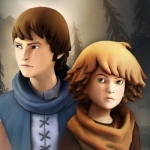
Brothers: A Tale of Two Sons
Games and Entertainment
App
**Supported Devices iPhone 5, iPad 4, iPad Air and iPad Mini 2 or newer devices.** Critically...

Shell Shocked: My Life with the Turtles, Flo and Eddie, and Frank Zappa, Etc...
Howard Kaylan, Jeff Tamarkin and Penn Jillette
Book
If Howard Kaylan had sung only one song, the Turtles' 1967 No. 1 smash hit "Happy Together", his...
Purple Phoenix Games (2266 KP) rated Werewolf: A Party Game for Devious People in Tabletop Games
Jun 24, 2021
Disclaimer: We were provided with a copy of this game for the purposes for this review. What you see is a finalized production copy, and is what would be received in a retail copy. -L
Werewolf: A Party Game for Devious People (simply referred to as Werewolf from here on out), is a game of bluffing and deduction in which players are attempting to complete their objective, based on their secret roles. Werewolves are trying to outnumber the Villagers, and Villagers are trying to kill all the Werewolves. To setup for a game, assemble the deck of role cards. Each deck will always have 1 Moderator card, a number of Werewolf cards, and a number of Villager cards depended on the player count. For example, a 5-player game would have 1 Moderator, 1 Werewolf, and 3 Villagers. Each player is dealt one card and keeps their role a secret, except the Moderator. The game is now ready to begin.
Each round consists of a Night and Day phase, all facilitated by the Moderator. To start the Night phase, all players (except for the Moderator) will close their eyes. The Moderator prompts the Werewolf to awaken (open eyes) and silently point to a Villager to kill. The Werewolf then closes their eyes, and the Night phase ends. To start the Day phase, the Moderator will have all players open their eyes, and will reveal which player has been killed in the night. All remaining ‘living’ players now have a chance to discuss amongst themselves and try to figure out the identity of the Werewolf. Accused players have a chance to defend themselves, and may even throw the blame to other players. Once players reach a consensus, they will kill off the accused Werewolf. If the accused player was the Werewolf, then the Villagers win (in a 5-player game)! If the accused player was not the Werewolf, then a new round begins with a Night phase, and the Werewolf is one step closer to winning. The game ends when either the Villagers have killed the Werewolf, or the Werewolf equals or outnumbers the Villagers.
The above description is a generic rundown of the game. Many versions of Werewolf have additional roles/abilities to enhance the gameplay and add new elements to the strategy. This particular version of Werewolf does indeed include optional additional roles. Those roles are: Seer, Doctor, Drunk, Witch, and Alpha Werewolf. These optional roles grant players additional abilities/powers for use during play. For example, every Night phase, the Seer can silently ask the Moderator whether a single player is a Werewolf or not. That can definitely help in the Day phase when it is time to accuse people! The addition of these roles helps to enhance the strategic gameplay by offering more for players to do, rather than just blindly accuse and guess each round. Included in the tuck box are even some blank role cards for you to create your own roles/powers if you so choose.
The major downside to any version of Werewolf is that once a player has been killed off, if they were not the Werewolf, they are out of the game for good. So even if the game lasts for 20 more minutes, that player just has to sit there in silence.
Components. This particular Werewolf consists of a deck of role cards, rules, and a guide for the Moderator. The quality of the cards is nice, and they are easy to manipulate and are sturdy. The artwork is very minimalistic in this game, and it actually works pretty well since Werewolf really isn’t a component-based game. All in all, a good quality deck of cards.
Overall, this is just a normal game of Werewolf. Honestly, you don’t really even need any components to play – as long as everyone knows the rules and roles, you are good to go. Does having a deck of cards help? In some ways, yes. But it kind of just feels redundant to me, since I already knew how to play the game. If you’re wanting to introduce someone to the Werewolf-type game, this little deck of cards would be a good way to do it. Personally, this type of game appealed to me more as a child/teen, and it kind of falls flat to me now as an adult, thus my low score. I don’t see this game staying in my collection forever, but it had a decent run while it was here. Purple Phoenix Games gives it a calculated 4 / 12. If you’ve played any variation of Werewolf before, there’s really no need to check out this particular iteration.
Purple Phoenix Games (2266 KP) rated Spy Club in Tabletop Games
Aug 12, 2021
Spy Club is a cooperative memory and deduction card game utilizing an action point system and sharing of resources. It is set in any neighborhood where kids can gather in groups and snuff out a mystery. The goal is to whittle the clues down to the correct Motive, Suspect, Location, Crime, and Object of the Crime. Are you intrepid youths up to the task?
To setup, place the main board on the table, and the Escape Marker upon it at the bottom of the track. Shuffle the Movement Deck cards separately by backs, remove one from each differently-backed set, and place them in day – sunset – night order in its space. Each player receives a play board according to the number of players and a spyglass in their favorite color to go upon their play board. The Idea markers can be in a rough pile near everything else. The Clue Deck is to be shuffled and placed face-down (or face-up, whichever you prefer; they are double-sided) and each player is dealt a number of Clues equal to the number of spaces on their play boards. Clues will also be dealt to an “Incoming Clues” area (an offer row or “market”). DO NOT LOOK AT THE BACKS OF THE CARDS. Like, EVER. Unless you use an action to do so. The Suspecteeple will be placed on the right-most Clue Card of the starting player’s board. The game of sleuthing may now begin!
A player’s turn will consist of three main steps with different phases in those steps. Step 1 is Use Actions. Players will be able to use three Actions on their turn. These Actions are: Investigate, Shift Focus, Confirm, and Scout. To Investigate the active player will flip a Clue Card from their collection to its back. They may then continue flipping their cards or stop at any time. To Shift Focus a player will simply move their spyglass to a different Clue and collect Ideas equal to the number of Clues whose aspects match the newly-focused one (two Ideas if moving to a Location and a player has two Location Clues). Skipping Confirm, to Scout simply means purchasing a card from the Incoming Clues area to a player’s board, with a discard of an existing card already there.
Confirming is where the main action in Spy Club lies. Players will be attempting to Confirm five Clues of matching aspect (Location, Motive, etc) in order to hone in on the correct aspect. To Confirm, a player can submit a Clue from their collection (hand) to the main board. The cost, in Ideas, depends on where the spyglass lies. If the spyglass is directly under the Clue to be submitted the cost is nothing. However, if a player wishes to complete three Confirm actions and they have matching Clues on either side of their spyglass, they would need to spend two Ideas for each Clue resting one space away from the spyglass.
There are also rules for taking “Teamwork Bonus Actions,” but I will let you discover those on your own.
After these Actions are carried out, Step 2 is Refill. Firstly the active player’s hand will need to be refilled from the Incoming Clues row, and more Incoming Clues come out to fill that row.
Step 3 is Move the Suspect. Drawing from the Movement Deck the active player will match up the Movement cards from the previous round and the current round to find out how many spaces the Suspecteeple will be moving through players’ cards. Depending upon which aspect Clue the Suspecteeple lands a negative action will be levied against the players. In some ways the Suspect could land on cards that trigger no negative action, but I will leave that for you to discover as well. I am a bit… distracted.
Play continues in this fashion of players Using Actions, Refilling the Clue cards, and Moving the Suspect until players win by solving all five aspects of the crime, the Suspect escapes, the players run out of Idea markers, the Suspect escapes due to running out of Movement cards, or there are insufficient Incoming Clues to refill a player’s hand. So there are four ways to lose and one way to win.
Components. I find the components in Spy Club to be good overall. Nothing really stands out as amazing, either in design or quality. The art is very good, though. One thing I will say about the components as a whole is that once the game is setup and in play it looks fascinating on the table. I love the way it looks and certainly assists with full immersion. Always a plus in my book.
There are so many things I love about this game. And there are so many things I didn’t even explain here! Ok I’ll tell you one. Spy Club can be played as a one-shot game night medium-length (60 minutes) game, or can be converted into a campaign game where players will play five connected scenarios using a giant stack of cards that are not in use for the one-shots. That is simply fabulous! I can play one game of this to get people hooked, then reel them in by offering to continue this as a campaign to see what the main story arc is really trying to tell us. Oh man, that’s just special and I love it!
I feel like I have been playing a lot of really great games lately, and Spy Club is certainly a GREAT game. In fact, I told the rest of the team that this one is a contender for my Top 10 Games of All Time list. It has everything I love in a game: it is difficult (my first game I would have lost had it lasted one more turn) without being too heavy, it is inviting me to play more games (especially with the campaign mode active), I just like looking at it on the table, and creates a stunning amount of tension as we race against the game clock to figure out the crime aspects.
I have had this in my collection for too long without it being played, and I am so sorry that it took me so long to get into it. I will certainly be playing this a LOT more, and introducing as many people to it as I can. I think in the gaming world it is flying under the radar, but I will be one of its champions and suggest it as much as possible. If you like certain aspects (hehe) of Clue, 13 Dead End Drive, Carmen Sandiego, and even Jaipur, then take a look at Spy Club. Purple Phoenix Games gives this a super-sleuth 11 / 12. I actually might go play it right now. Yes, at 11:07pm.

Airlines Europe
Tabletop Game
Before Ticket to Ride, before Santa Fe Rails, before Union Pacific – yet after Acquire – there...
BoardGames AlanRMoonGames AirlineGames
Purple Phoenix Games (2266 KP) rated Hierarchy in Tabletop Games
Oct 1, 2019
Hierarchy is an abstract strategy game of perfect information for 2 players. Comprised of a mere 14 playing cards (excluding title and reference cards) it is quite the compact game – as is to be expected from the Button Shy crew. In a game of Hierarchy, players take turns playing cards from their open hand (no hidden information here!) on top of the last card played by their opponent, per the placement restrictions. To win, you must be able to play a card on top of which your opponent is unable to play a card – effectively ‘checkmating’ them and claiming victory for yourself!
DISCLAIMER: We were provided a prototype copy of this game for the purposes of this review. As this is a preview copy of the game, I do not know if the final rules or components will be similar or different to what we were provided. -T
Here’s how it works in detail. Each player first receives a Quick Reference Card, and is then dealt half of the deck (7 cards). The cards are double-sided to represent the two player colors – purple and gold – so each player flips their 7 cards to show their chosen color. Since this is a game of perfect information, all cards are laid out on the table, so each player always knows what cards their opponent has available to them. The player who was dealt the ‘Imposter’ card goes first. Each card has a specific number, ranging from 1 to 13, as well as a specific ability. To play a card, its number must be higher than that of the card below it, unless the card’s specific ability says it can be played otherwise. For example, if I play the Queen (#12), Travis could play the King (#13, numerically higher) or the Assassin (#1) since its power allows it to be played atop any card except for the Tower and Leper. Don’t be worried about having to memorize all the card abilities – they are all detailed on the Quick Reference Cards (see photo below). Play continues back and forth until one player is unable to play a card, either because they have no cards left at all or because they have no valid cards left to play. That player loses the game, and the remaining player is the top of the Hierarchy! (Roll credits)
Let’s talk components first. They’re excellent, which is no surprise coming from ButtonShy. Of course, we just have a preview copy of the game, so I can only imagine that the card quality might be up for improvement during the Kickstarter. That being said, the cards we received are nice and sturdy, as is the tell-tale wallet of a ButtonShy game. The text on the cards is a good size, and the font is easy to read. The artwork is fine, but quite honestly not something I looked at in depth until Travis mentioned the style. I think that’s because the cards are all monochrome, the art just didn’t really draw my eye. Not a knock on the game, just something I noticed! Speaking of color, I personally love the player color choices of Purple and Gold – the school colors of my Alma Mater ((the University of Northern Iowa, go Panthers!)(also of the Alma Mater of the rest of us – Western Illinois University – GO NECKS! -T)). Maybe I’m biased, but I think those two colors are a great combination 🙂
And how about the gameplay? I think it’s excellent. For such a compact and ‘light’ game, the strategy required for success keeps the game extremely engaging. You always know the cards your opponent has, and you’ve got to be thinking at least several turns in advance to try to back them into a corner while not letting yourself fall victim to an unnoticed strategic play. Another neat thing about Hierarchy is how quickly it plays – typically in 20 minutes or less. You might have to devote a decent amount of brainpower to outwitting your opponent, but you definitely don’t need to devote hours of time during your game night for this game, and I love that. Gamers who enjoy games like Citadels or Love Letter might enjoy the familiarity of Hierarchy’s gameplay coupled with the intimacy of a strictly 2-player game. The final verdict from me is that Button Shy has another hit on their hands with Hierarchy. I am very much looking forward to following the campaign, and definitely plan to pull this game out many times in my future!
Purple Phoenix Games (2266 KP) rated The Grimm Forest in Tabletop Games
Apr 9, 2021
The Grimm Forest is a simultaneous action selection, set collection, take that game for four family members of the infamous Three Little Pigs. As fantasy contractors players are tasked with constructing three houses as sturdy and quickly as they can. However, these contractors will have competition for limited resources, as well as the occasional interference from scary creatures and buddies of opponents. Like the baseball movie says, “If you build it, you will win the contract to build more stuff.” Or something like that.
DISCLAIMER: We were provided a copy of this game for the purposes of this review. This is a retail copy of the game, so what you see in these photos is exactly what would be received in your box. I do not intend to cover every single rule included in the rulebook, but will describe the overall game flow and major rule set so that our readers may get a sense of how the game plays. For more in depth rules, you may purchase a copy online or from your FLGS. -T
To setup, place the Location boards on the table for the Fields, Forest, and Brickyard (for a three-player game, as below). The First Builder Bonus tokens are placed below the matching Locations as well as the resources that can be harvested. One of each Mega Resource (5 Straw, 4 Wood, 3 Brick) are placed on the matching Location at the beginning of each round. The Friend and Fable decks are shuffled and placed nearby, as are the House sections (Floors, Walls, Roofs – Rooves?), and the Monster minis. Each player chooses a color and collects the Player board, Pig mini, and Gather cards matching that color. The first player is given the Starting Player tome token and the game may now begin!
The Grimm Forest is played over a series of rounds with each pig having a multi-step turn. Initially, however, the pigs will be deciding from which Location they would like to harvest resources by laying the corresponding Gather card from their hand to the table face-down. Once all pigs have laid their card, the Gather cards are flipped and revealed simultaneously. If any pig had chosen to also play one Fable card it would have been revealed and possibly resolved prior to this step. Players will place their Pig mini on the Location board they chose and then harvesting of resources may begin, unless a player has a Fable card that resolves at this point in the turn. If a Pig is alone in a Location they receive all resources currently found there. If Pigs share a Location then the shared minis will share the resources equally, keeping any remaining resources on the Location for the next round. If any player used a Fable card that activates at the end of the Gather phase, it is resolved now.
After the Gather phase, the Pigs will be able to take actions. On their turn, in turn order, each Pig may choose to perform two of the following actions in any order they wish (actions may be repeated except for Friend Special Actions): Draw a Fable card, Gain 1 Resource, Build, Special Actions. Drawing a Fable card is self-explanatory and players will keep their Fable cards secret from the other players. They may choose to play one of these Fable cards during the choosing of Gather cards portion of the beginning phase of a turn. A Pig may instead wish to gain one resource of their choosing and add it to their collection. As mentioned earlier, a Pig may also use their active Friend card’s (which is earned by building a Wall section) Special Action once per turn, should they have collected one earlier.
The true hero of The Grimm Forest is the Build action as this is what propels players to victory. Pigs may Build any house type they wish, as long as that type is not currently under construction elsewhere on their board. Also note that houses must be built from the ground up so Floors must be present before Walls can be built and Walls need to be constructed in order to hold up a Roof. Pigs may build these sections of houses by discarding the appropriate number and type of resources they have gathered previously: two resources for a Floor, four resources for Walls, and six resources for a Roof. Once a Pig completes construction of the first house of a type they will grab the matching First Builder Bonus token and reap its rewards.
The game continues in this fashion until one player has built three houses of any type, or multiple players have completed their three houses by the end of the round. Those tied players then check for sturdiness to break their tie: brick houses are sturdier than wood, which are sturdier than straw. The winner is the player with the sturdiest collection of houses, and then all players are invited to share a plate of bacon in celebration of the win (not in the rules, but I added that for… flavor).
Components. This game is chocked full of killer components. I do not oftentimes compliment boxes and inserts, but when a game comes with GameTrayz already, you know that the publisher cared a ton about the game. Everything sets up and tears down so much nicer and quicker with a GameTrayz insert that I wish every game would come with them. Yeah, I know, $$$. Outside of the insert (or inside?) the other components in the game are simply stellar. Everything from the card backs resembling book covers, the incredible plastic house pieces, and amazing minis, just makes this one sing when on the table. The art is done by the incredible Mr. Cuddington, and they are quickly becoming some of my favorite board game artists.
Wait, there are monster minis? But I didn’t talk about that in my overview. Well, yes, that’s correct. These monsters come into play from certain Fable cards, and when they are played it instructs the player to introduce the appropriate monster mini on the playing area. This can be done with such dramatic flair that you truly get a sense of dread that little piggies may feel. If you have seen Stranger Things (not a sponsor) and remember the part when the Demogorgon mini hits the table, then you understand how I introduce my monster minis. These monsters wreak havoc on the players and sometimes deny them resources, and other chaos to mess with pigs.
Overall, I am so enamored with this game. It has nearly everything I love about games. It has amazing theme and art. That is always big with me. The components are super high quality, as all Druid City Games/Skybound Games usually are, and the game is so smooth once it is learned. All phases and turn components work together well, and there are plenty of choices each player makes every round. The game comes with advanced rules and components as well once all players are comfortable with the base game, and I love when games come with that added complexity and difficulty.
I have nothing bad to say about this game at all, which makes me sad, because I can usually find something to improve with every game I play. Okay wait, I just thought of one: I appreciate that the player colors include both orange and purple, but then the others are blue and green. I think the player colors could have come with some different choices as I feel blue, green, and purple are within similar color bands. Maybe pink and aqua would be better choices for my taste? I don’t know, and I am sure research was done to decide on the player colors, but like I said, I needed to find SOMETHING to complain about.
So it is certainly no surprise that I love this game and rated so highly. I doubt it will ever truly break into my Top 10, but I feel it ticks all of my boxes for a great game and a 6 from me. Purple Phoenix Games as a whole gives this one a porky 15 / 18. If you are looking for a great game that is admittedly lighter, but gives great gameplay throughout, features incredible art and components, and offers opportunities for role-play then you definitely need to grab a copy of The Grimm Forest. I will be recommending this to so many gamers in the future, and I will be pushing the floor of the age suggestion on the box once my son decides he wants to learn to read. I think I am going to go try out the Advanced rules now, and remember: don’t eat an apple that a scary person gave you at the door.

Inis
Tabletop Game
Inis is a game deeply rooted in Celtic history and lore in which players win by being elected King...
CelticGames BoardGames 2016Games

